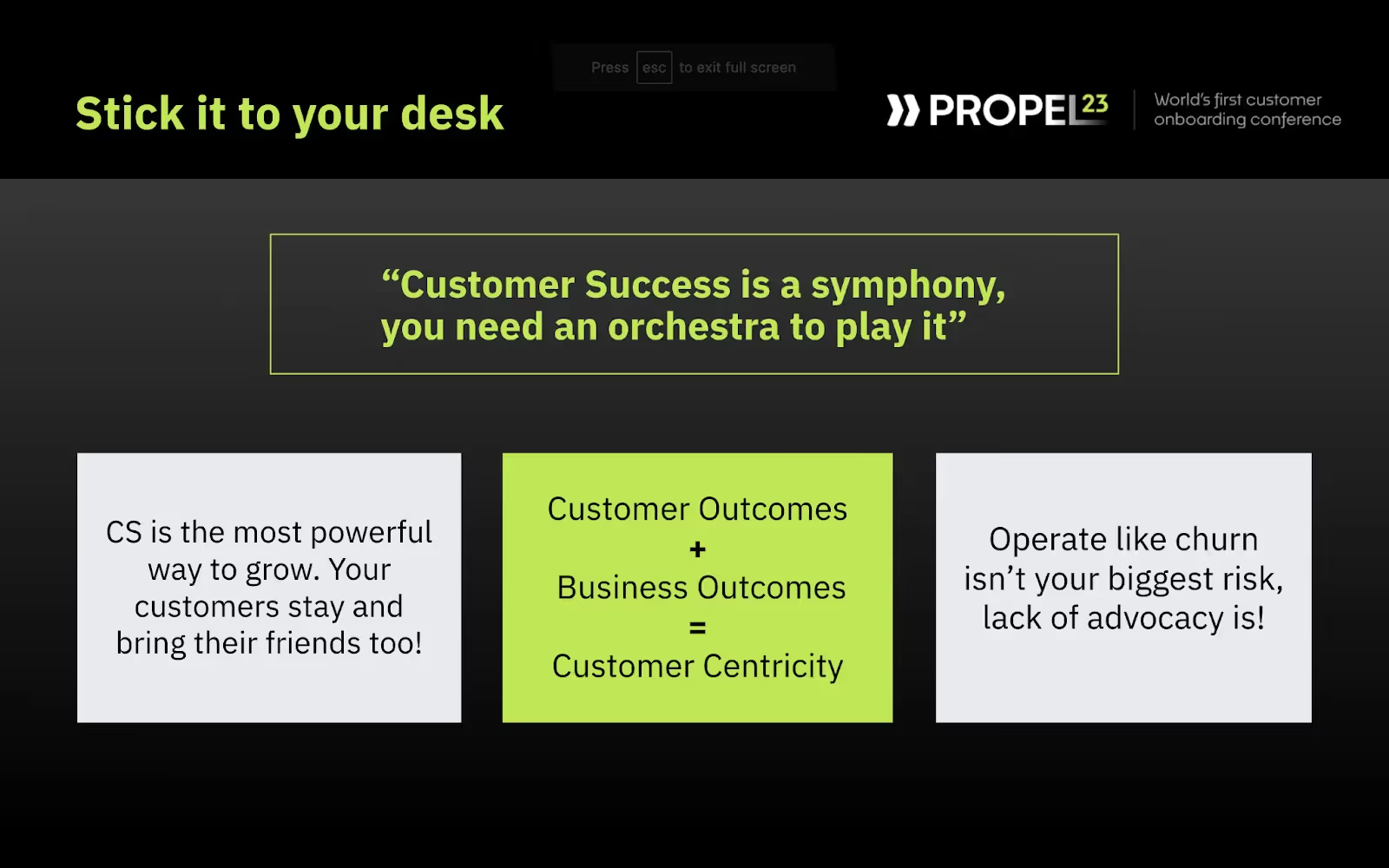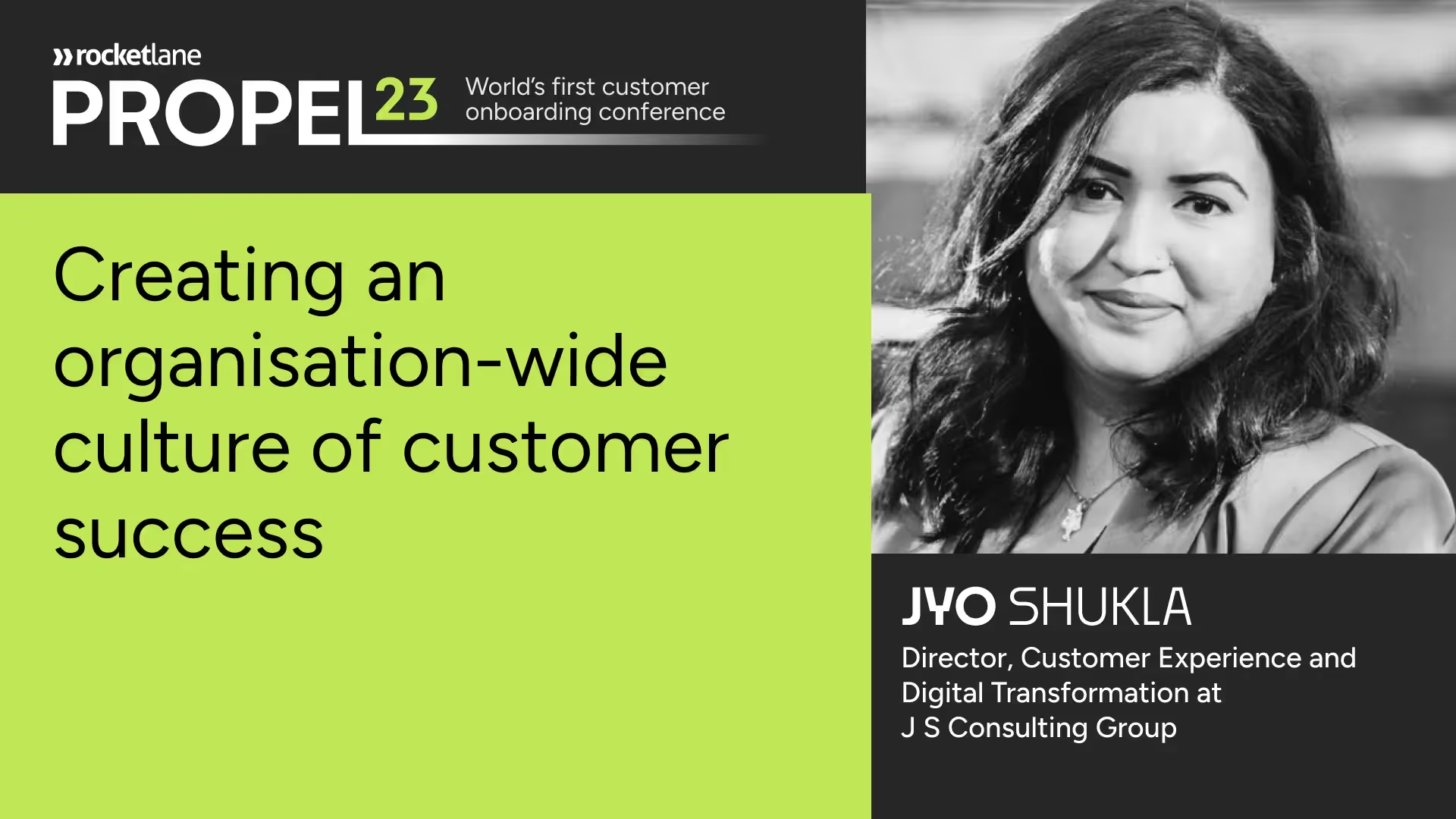Further reading
- Learn how to create a customer-centric framework for onboarding
- Here’s a guide on how to drive customer adoption through shared KPIs for CS and Product
- What does it take for CS and Product teams to collaborate successfully? Find out here
- Here’s a quick guide to the ultimate Sales-to-Customer-Success handoff. Includes a free template!
- Learn how to make your post-sale product journeys customer centric here
- Who thinks you're customer-centric? You or your customers?
Jyo Shukla is the Director of Customer Experience and Digital Transformation at J S Consulting Group, a multi-award-winning digital transformation and CS leader, and author of the highly acclaimed book Customer Success Mindset. Jyo has spent most of her career helping startups and enterprises across the globe drive better business outcomes using technology and build customer-centric growth strategies.
In her Propel23 session, Jyo Shukla spoke about how one can build a practice of Customer Success beyond just the customer journey. She provides some useful tips on catalyzing change, bringing a practical transformation, and operationalizing and evangelizing Customer Success across the org.
Throughout Jyo’s career, she has dedicated herself to the field of customer success, demonstrating her passion for nurturing and fostering successful customer relationships. Beyond her professional endeavors, Jyo is a self-proclaimed Masterchef. She drew a parallel between her experience in baking cakes and the prevailing approach to customer success in many organizations.
The discrepancies in the Customer Success recipe
When she first began baking cakes, Jyo experimented with various recipes, adjusted ingredient measurements, and explored different strategies. Despite her best efforts, the cakes consistently fell short of expectations. It became apparent that something was missing and that the approach needed refinement. Similarly, she observed a similar discrepancy in the customer success practices employed by many companies today.
Companies often proclaim their dedication to customer-centricity and to placing the customer at the forefront of their operations. Although the claims are well-intentioned, there is a disconnect between their claims and reality upon closer examination. Delving deeper, it becomes evident that Customer Success is often treated as a mere department rather than an overarching strategy within these organizations. Even in companies boasting established CS departments, the philosophy of Customer Success and shared responsibility for customer satisfaction tends to be lacking.
This disparity significantly strains customer success teams. In most cases, the prevailing perception of Customer Success reduces it to a siloed function, where the responsibility for managing customers falls solely on the CS team. They are expected to single-handedly guide customers toward achieving their desired outcomes while simultaneously navigating internal and external demands. Even with regard to metrics, this burden is evident. For instance, metrics like time-to-first-value are typically attributed solely to the customer onboarding team, while metrics such as churn rate or net retention rate are unquestionably viewed as the customer success team's responsibility. It gives the impression that other teams within organizations have not invested adequate efforts to understand the underlying stories or value behind these metrics.
In light of these observations, it becomes imperative to rethink the approach to Customer Success. Embracing Customer Success as a strategic philosophy and recognizing that it is not confined to a single department can lead to more effective outcomes. By fostering a culture where everyone shares the responsibility for customer satisfaction, organizations can create a stronger foundation for sustainable success. This requires a collective effort to understand the nuances of customer metrics and their implications, enabling us to provide the guidance and support necessary for our customers to thrive.
The customer success department is tasked with resolving the ‘churn problem’ and assisting customers in achieving their objectives. However, assuming full responsibility for both successes and failures weighs heavy, and turns Customer Success into a reactive firefighting department. Their time is predominantly spent on salvaging situations, which results in a critical issue: Customer Success professionals and leaders primarily engage in the business's operational aspects rather than the strategy. This situation hampers the ability to deliver optimal outcomes to both customers and the organizations that the CS departments serve. Therefore, it is imperative to collaboratively find an improved approach to enhance effectiveness and drive superior results for customers and companies.
Whisking up a wonderful customer experience
The key to transforming the cake-making technique lies in using a whisk. While it's important to follow the recipe and add all the ingredients correctly, mixing them together is crucial. By understanding the science of baking, we learn that the technique used to mix ingredients and create air in the batter contributes to the fluffiness and taste of the cakes. Similarly, a Customer Success leader’s role is like that of a great whisk in a cake. If the other departments in the company provide the ingredients for the cake, the work of Customer Success is to act as the whisk that brings everything together in a holistic and consistent customer experience. This experience is then delivered to customers.
It is essential for Customer Success leaders to internally sell the value of customer success and help other departments understand their role in the success of our customers. Rather than merely transferring the responsibility to Customer Success, the organization as a whole must internalize the value and become catalysts for change, so that every individual takes responsibility for the customer in their own way. They should understand what this responsibility entails and how its impact is measured. This approach allows the organization to become more customer-centric, and for Customer Success leaders and professionals to find more fulfillment in their work. To initiate this collaboration, Jyo identified four key departments and provided tips on implementing small changes in operations.
Getting Sales and Customer Success to see eye-to-eye
The primary focus of the sales team is on achieving their targets, expanding existing accounts, and generating referrals. Establishing effective communication with the sales team can be challenging. So, how can you ensure they understand your objectives while getting the information you need?
The critical information you require from the sales team lies in the pre-sales stage, where important insights about the customer's motivations are uncovered. These conversations, which take place before deals are finalized, reveal the customer's goals, pain points, and strategic objectives. Ensuring a smooth handoff to the onboarding or customer success teams relies on accurately translating this information. As the customer progresses along their journey, this responsibility is typically transferred to the customer success or onboarding teams, as they gain insights into the customer's evolving goals. This information becomes valuable for identifying upsell, cross-sell, and referral opportunities.
Throughout the different stages of the customer journey, both the sales and customer success teams possess unique pieces of information that can mutually benefit each other. Therefore, the standard practice should be to document this information in an account plan. However, the account plan should not be solely the responsibility of the customer success team, and should be initiated by the sales team. This way, the sales team can consolidate all their discovery information, stakeholder profiles, and internal strategies into a single document, which is the handoff to the customer success or onboarding teams.
To maintain alignment, it is recommended to update the account plan every quarter, a practice that Jyo herself has successfully implemented previously. It is not enough to merely document this information, though. Regular account reviews should also be conducted with the sales team. These reviews provide an opportunity to discuss goals, uncover valuable insights from the customer, and act as the eyes and ears of the sales team. By demonstrating commitment in this way, the sales team's support and cooperation can be effectively gained.
In order to promote collaboration between sales teams and other departments, it is important to overcome the challenges that may arise. Actively participating in quarterly sales meetings and highlighting the value of collaboration is an effective strategy. By showcasing the positive outcomes, such as retention and expansion resulting from sales and customer success working together, the importance of adopting best practices can be emphasized. Celebrating even small wins can reinforce the value of collaboration and encourage adopting practices such as proper documentation and account reviews. Remembering that individual contributions and successes can benefit the entire team is crucial. Significant results can be achieved by implementing these small changes and providing support.
Getting on par with Product
A good product is designed to solve customer problems or fill process gaps, but a great product evolves while staying true to its core messaging in response to market changes. Product teams are crucial in helping customer success teams understand the product's vision and roadmap, enabling better customer conversations. Partnering with product teams and leaders is essential, as Customer Success can provide invaluable insights from customers that may lead to great product ideas.
While not all customer-requested product features may make it into the product roadmap, maintaining open communication between Customer Success and the product team is vital. One approach that has proven effective is a regular forum or meeting between the two teams with three key agenda items.
First, Customer Success does its homework and selects the top five customer product ideas, which are then discussed alongside the product roadmap. Not every idea may be suitable for discussion, but a few are chosen for a brainstorming session with the product team.
The teams discuss how Product can assist in defining important in-app adoption metrics. These metrics help Customer Success identify at-risk customers and define excellence in product uptake and adoption. Such metrics coming directly from the product team become highly relevant and beneficial in evolving customer health scores or risk assessment processes.
The teams can also discuss pain points, risks, or churn feedback related to the product received from customers. The focus is on product-specific churn, not customers who weren’t the right fit for the product. This conversation can also address potential user experience or customer experience issues, with the aim of improving the product experience for customers.
These meetings foster robust conversations and lead to valuable takeaways for both the product and customer success teams. Even unspoken ideas during the meeting can have a significant impact on collaboration with customers and internal teams, ultimately resulting in positive outcomes and a better product experience for customers. By making small but meaningful changes to how teams collaborate, great outcomes can be achieved.
Making Marketing your best mate
For Customer Success, Marketing is a vital ally. This is particularly relevant for those in CSM or CS leadership positions dealing with a high CSM-to-account ratio. In such scenarios, Marketing can prove to be invaluable. Collaborating with your marketing team allows for implementing mass messaging or customer outreach. For example, hosting a webinar tailored to a specific customer segment ensures that only relevant information is shared, as opposed to broadcasting to a broad audience. CS teams contribute insights to the marketing team, guiding them on which strategies would be effective for each customer segment. Face-to-face interactions with customers, rather than impersonal mass emails, are far more effective. Starting with a well-executed webinar in partnership with your marketing team, and crafting targeted messaging for specific customer segments, can yield positive results.
Another successful approach that Jyo implemented involved creating weekly "Do You Know" videos. Each video lasted two to three minutes, and instead of discussing product features, they addressed industry challenges. These videos were then circulated among targeted customer segments through the marketing team. The result was increased engagement and a surge in customer questions. The time saved through these targeted approaches allowed for personalized conversations with customers, while the high engagement rates helped to re-engage previously disinterested customers. This partnership between Customer Success and Marketing combines the advantages of digital and human interactions, resulting in tailored communication that benefits everyone involved.
Getting executive support
The engagement of executive leaders is critical for driving a customer-centric organization. As customer success leaders, we have the ability to initiate this change, but it ultimately requires a shift in strategy, which our executive leaders can champion.
However, it's important to note that the language spoken by the board revolves around numbers and strategy. Therefore, it is suggested that as CS leaders, or members of the CS team, we take the initiative to define a Northstar metric for customer centricity.
When she was a customer success leader at a startup, Jyo approached the board to address the discrepancy between their claims of being customer-centric and the lack of a metric to measure it. They collectively brainstormed and established a metric that aligned with the organization. If you believe there is a comprehensive metric that encompasses customer centricity, it's crucial to formalize and gain agreement from your leadership team.
Once the metric is established, the next step is determining how different teams contribute to it and integrating it into their KPIs. This top-down approach is essential because individual efforts are insufficient to drive the necessary changes. Working closely with the leadership team can help break down the metric, and educate each team about their role and how it aligns with the overarching goal of customer centricity. Furthermore, this process allows you to identify gaps and areas that require investment, ultimately strengthening your case for additional resources. As the metric becomes integrated into people's performance evaluations, you can hold each department leader accountable for their team's contribution to customer success and encourage collaboration. Ultimately, this approach brings all the previously mentioned steps together, as the impetus for change comes from the leadership team.
The perks of having the entire organization be customer-centric

One can witness enhanced processes and a more content workforce by dedicating more time to working on the business rather than in it. At the risk of sounding cliché, these improvements truly have a "wow" factor. However, implementing these changes is not always easy and involves significant adjustments in mindset and responsibility.
If attempts at change in your organization aren't leading to expected results, it's important to remember that transformation is often imperfect and slow. Patience is key when bringing about change. Although the outcomes might not initially meet expectations, the improvements will slowly become apparent.
Remember, building efficient processes takes time, so commitment and the support of your executive team and other departments is critical.
Jyo’s mantras for customer success leaders

If you ever feel lost in your professional journey, here are four key principles that Jyo recommends to help you remember the importance of your role as a CS leader or professional (Tip: Turn them into sticky notes).
Your role plays a crucial part in the growth of your organization. Just like playing a symphony, Customer Success requires bringing everyone along on the journey. This is also the most effective strategy for driving growth. By aligning your business outcomes with those of your customers, you can ensure that they return and even refer others to your product or service. Currently, the software industry prioritizes customer retention as the main risk. This mindset needs to change. Our truest risk lies in failing to turn our customers into enthusiastic product advocates. Once we shift our focus, we can unlock the true magic of customer success.
Jyo’s magic success metric
Jyo Shukla revealed her singular Northstar success metric - growth rate. The growth rate metric incorporates the NRR and encompasses a comprehensive mathematical framework to measure it. It also considers the influx of new sales and business generated through customer referrals. These two factors highlight the significance of repeat customers and the positive influence they have on attracting new customers.
It is crucial to assess not only the mathematical aspect of this metric but also delve into the narrative behind it. Understanding the intricate details and breaking it down requires a considerable amount of time and effort. Although calculating the NRR is relatively straightforward, determining the new business through referrals necessitates a robust strategy. Addressing the allocation of credit poses potential challenges and requires thoughtful discussions.
Harnessing real-time data for Customer Success and product adoption
In order to achieve excellence in product adoption, it is crucial to have a combined view of data for both CS and product teams that can be reviewed in real-time. This eliminates the need to collate and report on the data once a month. While there are tools available in the market, such as Pendo, that facilitate adoption measurement, the problem lies in how these tools are utilized. Some mature CS organizations fail to implement these tools effectively, resulting in irrelevant outputs. It is important to distinguish between product metrics and customer health metrics.
Product teams focus on metrics such as the usage of specific product features by customers in certain industries, which can be sourced from tools like Pendo. However, for customer success teams, these metrics may not be as relevant as they are more concerned with understanding the overall health of individual customers. Therefore, while having a common language and real-time visibility into product performance is beneficial, it is equally important to have regular reporting that emphasizes the customer's overall health rather than just deep product metrics that are more useful for the product team.



















